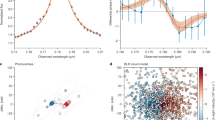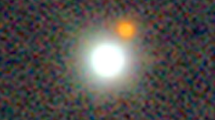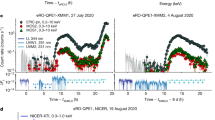Abstract
Quasars have long been known to be variable sources at all wavelengths. Their optical variability is stochastic and can be due to a variety of physical mechanisms; it is also well-described statistically in terms of a damped random walk model1. The recent availability of large collections of astronomical time series of flux measurements (light curves2,3,4,5) offers new data sets for a systematic exploration of quasar variability. Here we report the detection of a strong, smooth periodic signal in the optical variability of the quasar PG 1302−102 with a mean observed period of 1,884 ± 88 days. It was identified in a search for periodic variability in a data set of light curves for 247,000 known, spectroscopically confirmed quasars with a temporal baseline of about 9 years. Although the interpretation of this phenomenon is still uncertain, the most plausible mechanisms involve a binary system of two supermassive black holes with a subparsec separation. Such systems are an expected consequence of galaxy mergers and can provide important constraints on models of galaxy formation and evolution.
This is a preview of subscription content, access via your institution
Access options
Subscribe to this journal
Receive 51 print issues and online access
$199.00 per year
only $3.90 per issue
Buy this article
- Purchase on Springer Link
- Instant access to full article PDF
Prices may be subject to local taxes which are calculated during checkout




Similar content being viewed by others
References
Kelly, B. C., Bechtold, J. & Siemiginowska, A. Are the variations in quasar optical flux driven by thermal fluctuations? Astrophys. J. 698, 895–910 (2009)
Pojmanski, G. The All Sky Automated Survey. Catalog of Variable Stars. I. 0 h – 6 h Quarter of the Southern Hemisphere. Acta Astronom. 52, 397–427 (2002)
Udalski, A. et al. The optical gravitational lensing experiment. Discovery of the first candidate microlensing event in the direction of the Galactic Bulge. Acta Astronom. 43, 289–294 (1993)
Rau, A. et al. Exploring the optical transient sky with the Palomar Transient Factory. Publ. Astron. Soc. Pacif. 121, 1334–1351 (2009)
Sesar, B. et al. Exploring the variable sky with LINEAR. I. Photometric recalibration with the Sloan Digital Sky Survey. Astron. J. 142, 190–202 (2011)
Valtonen, M. J. et al. A massive binary black-hole system in OJ287 and a test of general relativity. Nature 452, 851–853 (2008)
Valtonen, M. J., Lehto, H. J., Takalo, L. O. & Sillanpää, A. Testing the 1995 binary black hole model of OJ287. Astrophys. J. 729, 33–38 (2011)
Ju, W., Greene, J. E., Rafikov, R. R., Bickerton, S. J. & Badenes, C. Search for supermassive black hole binaries in the Sloan Digital Sky Survey spectroscopic sample. Astrophys. J. 777, 44–59 (2013)
Shen, Y., Liu, X., Loeb, A. & Tremaine, S. Constraining sub-parsec binary supermassive black holes in quasars with multi-epoch spectroscopy. I. The general quasar population. Astrophys. J. 775, 49–71 (2013)
Tsalmantza, P., Decarli, R., Dotti, M. & Hogg, D. W. A systematic search for massive black hole binaries in the Sloan Digital Sky Survey spectroscopic sample. Astrophys. J. 738, 20–28 (2011)
Drake, A. J. et al. First results from the Catalina Real-Time Transient Survey. Astrophys. J. 696, 870–884 (2009)
Djorgovski, S. G. et al. in The First Year of MAXI: Monitoring Variable X-ray Sources (eds Mihara, T. & Kawai, N. ) 263–268 (JAXA Special Publication, 2010); available at http://maxi.riken.jp/FirstYear/proceedings/procindex.html
Mahabal, A. A. et al. Discovery, classification, and scientific exploration of transient events from the Catalina Real-time Transient Survey. Bull. Astron. Soc. India 39, 387–408 (2011)
Hinshaw, G. et al. Nine-year Wilkinson Microwave Anisotropy Probe (WMAP) observations: cosmological parameter results. Astrophys. J. 208 (suppl.). 19–43 (2013)
Garcia, A., Sodré, L., Jablonski, F. J. & Terlevich, R. J. Optical monitoring of quasars — I. Variability. Mon. Not. R. Astron. Soc. 309, 803–816 (1999)
Eggers, D., Shaffer, D. B. & Weistrop, D. Optical variability of radio-luminous PG quasars. Astron. J. 119, 460–468 (2000)
Bahcall, J. N., Kirhakos, S. & Schneider, D. P. Hubble Space Telescope images of nearby luminous quasars. II. Results for eight quasars and tests of the detection sensitivity. Astrophys. J. 450, 486–500 (1995)
McLure, R. J. et al. A comparative HST imaging study of the host galaxies of radio-quiet quasars, radio-loud quasars and radio galaxies — I. Mon. Not. R. Astron. Soc. 308, 377–404 (1999)
Hutchings, J. B., Morris, S. C., Gower, A. C. & Lister, M. L. Correlated optical and radio structure in the QSO 1302–102. Publ. Astron. Soc. Pacif. 106, 642–645 (1994)
Benítez, E. et al. The close environment of OJ 287: underlying nebulosity and a possible optical jet? Astrophys. J. 464, L47–L50 (1996)
Jackson, N. et al. Monitoring of active galactic nuclei. I — The quasars 1302-102 and 1217+023. Astron. Astrophys. 262, 17–25 (1992)
Shen, Y. & Loeb, A. Identifying supermassive black hole binaries with broad emission line diagnosis. Astrophys. J. 725, 249–260 (2010)
Gaskell, C. M. Close supermassive binary black holes. Nature 463, E1 (2010)
Lu, J.-F. & Zhou, B.-Y. Observational evidence of jet precession in galactic nuclei caused by accretion disks. Astrophys. J. 635, L17–L20 (2005)
Shen, Y. et al. A catalog of quasar properties from Sloan Digital Sky Survey data release 7. Astrophys. J. 194 (suppl.). 45–65 (2011)
Farris, B. D., Duffell, P., MacFadyen, A. I. & Haiman, Z. Binary black hole accretion from a circumbinary disk: gas dynamics inside the central cavity. Astrophys. J. 783, 134–145 (2014)
Rafikov, R. R. Structure and evolution of circumbinary disks around supermassive black hole binaries. Astrophys. J. 774, 144 (2013)
Tremaine, S. & Davis, S. W. Dynamics of warped accretion discs. Mon. Not. R. Astron. Soc. 441, 1408–1434 (2014)
Bogdanović, T., Smith, B. D., Sigurdsson, S. & Eracleous, M. Modeling of emission signatures of massive black hole binaries. I. Methods. Astrophys. J. 174 (suppl.). 455–480 (2008)
Skrutskie, M. F. et al. The Two Micron All Sky Survey. 2MASS. Astron. J. 131, 1163–1183 (2006)
Larson, S. et al. The CSS and SSS NEO surveys. Bull. Am. Astron. Soc. 35, 982 (2003)
Landolt, A. U. UBVRI photometric standard stars around the sky at −50° declination. Astron. J. 133, 2502–2523 (2007)
Landolt, A. U. UBVRI photometric standard stars around the celestial equator: updates and additions. Astron. J. 137, 4186–4269 (2009)
Foster, G. Wavelets for period analysis of unevenly sampled time series. Astron. J. 112, 1709–1729 (1996)
Alexander, T. Improved AGN light curve analysis with the z-transformed discrete correlation function. Preprint at http://arXiv.org/abs/1302.1508 (2013)
McQuillan, A., Aigrain, S. & Mazeh, T. Measuring the rotation period distribution of field M dwarfs with Kepler. Mon. Not. R. Astron. Soc. 432, 1203–1216 (2013)
MacLeod, C. L. et al. Modeling the time variability of SDSS Stripe 82 quasars as a damped random walk. Astrophys. J. 721, 1014–1033 (2010)
Shen, Y. et al. A catalog of quasar properties from Sloan Digital Sky Survey data release 7. Astrophys. J. 194 (Supp.). 45–65 (2011)
Haiman, Z., Kocsis, B. & Menou, K. The population of viscosity- and gravitational wave-driven supermassive black hole binaries among luminous active galactic nuclei. Astrophys. J. 700, 1952–1969 (2009)
Volonteri, M., Miller, J. M. & Dotti, M. Sub-parsec supermassive binary quasars: expectations at z<1. Astrophys. J. 703, L86–L89 (2009)
Oke, J. B. et al. The Keck Low-Resolution Imaging Spectrometer. Publ. Astron. Soc. Pacif. 107, 375–385 (1995)
Cushing, M. C., Vacca, W. D. & Rayner, J. T. Spextool: a spectral extraction package for SpeX, a 0.8-5.5 micron cross-dispersed spectrograph. Publ. Astron. Soc. Pacif. 116, 362–376 (2004)
Vacca, W. D., Cushing, M. C. & Rayner, J. T. A method of correcting near-infrared spectra for telluric absorption. Publ. Astron. Soc. Pacif. 115, 389–409 (2003)
Shen, Y. The mass of quasars. Bull. Astron. Soc. India 41, 61–115 (2013)
Kim, D., Im, M. & Kim, M. New estimators of black hole mass in active galactic nuclei with hydrogen Paschen lines. Astrophys. J. 724, 386–399 (2010)
Greene, J. E. & Ho, L. C. Active galactic nuclei with candidate intermediate-mass black holes. Astrophys. J. 610, 722–736 (2004)
Glikman, E. et al. The FIRST-2MASS red quasar survey. Astrophys. J. 667, 673–703 (2007)
Raiteri, C. M. et al. Optical and radio variability of the BL Lacertae object AO 0235+16: a possible 5-6 year periodicity. Astron. Astrophys. 377, 396–412 (2001)
Fan, J. H. et al. Optical periodicity analysis for radio selected BL Lacertae objects (RBLs). Astron. Astrophys. 381, 1–5 (2002)
Kudryavtseva, N. A. et al. A possible jet precession in the periodic quasar B0605-085. Astron. Astrophys. 526, A51–A64 (2011)
Greenhill, L. J. et al. A warped accretion disk and wide-angle outflow in the inner parsec of the Circinus Galaxy. Astrophys. J. 590, 162–173 (2003)
Herrnstein, J. R., Moran, J. M., Greenhill, L. J. & Trotter, A. S. The geometry of and mass accretion rate through the maser accretion disk in NGC 4258. Astrophys. J. 629, 719–738 (2005)
Kondratko, P. T., Greenhill, L. J. & Moran, J. M. The parsec-scale accretion disk in NGC 3393. Astrophys. J. 678, 87–95 (2008)
Kuo, C. Y. et al. The Megamaser Cosmology Project. III. Accurate masses of seven supermassive black holes in active galaxies with circumnuclear megamaser disks. Astrophys. J. 727, 20–34 (2011)
Acknowledgements
This work was supported in part by NSF grants AST-0909182, IIS-1118031 and AST-1313422. We thank J. S. Stuart, MIT Lincoln Laboratory, for assistance with the LINEAR data. We also thank the staff of the Keck and Palomar Observatories for their help with observations, and the CRTS team. Some of the data presented here were obtained at the W.M. Keck Observatory, which is operated as a scientific partnership among the California Institute of Technology, the University of California and NASA. The observatory was made possible by the financial support of the W.M. Keck Foundation. The work of D.S. was performed at the Jet Propulsion Laboratory, California Institute of Technology, under a contract with NASA.
Author information
Authors and Affiliations
Contributions
M.J.G. performed the analysis and wrote the paper. S.G.D. is the PI of the CRTS survey and obtained the Keck spectrum. E.G. obtained and reduced the near-infrared data and provided the Balmer and Paschen line fits. D.S. reduced the Keck data. A.J.D. is the co-PI of the CRTS survey and provided the CRTS data. S.L. and E.C. are the PIs of the CSS survey. All authors contributed to the text.
Corresponding author
Ethics declarations
Competing interests
The authors declare no competing financial interests.
Extended data figures and tables
Extended Data Figure 1 The optical light curves of quasars showing radio periodicity.
Shown are the CRTS light curves for 11 quasars reported48,49 to show periodicity in their radio emission. Each light curve has been normalized to zero mean and individual curves are offset by a constant of 1.5 mag from each other. The data are split across two panels for ease of viewing. Error bars shown are standard 1σ photometric errors. The CRTS light curve of PG 1302−102 (solid black stars) is also shown for comparison.
Extended Data Figure 2 The optical light curves of quasars with warped accretion disks.
Shown are the CRTS light curves for 6 quasars reported51,52,53,54to have warped accretion disks. Each light curve has been normalized to zero mean and individual curves are offset by a constant of 0.5 mag from each other. Error bars shown are standard 1σ photometric errors. The CRTS light curve of PG1302−102 (solid black stars) is also shown for comparison.
Rights and permissions
About this article
Cite this article
Graham, M., Djorgovski, S., Stern, D. et al. A possible close supermassive black-hole binary in a quasar with optical periodicity. Nature 518, 74–76 (2015). https://doi.org/10.1038/nature14143
Received:
Accepted:
Published:
Issue Date:
DOI: https://doi.org/10.1038/nature14143
This article is cited by
-
Electromagnetic counterparts to massive black-hole mergers
Living Reviews in Relativity (2022)
-
Optical flux and spectral characterization of the blazar PG 1553 + 113 based on the past 15 years of data
Journal of Astrophysics and Astronomy (2022)
-
Multi-wavelength search for quasi-periodic oscillations in BL Lac 4FGL J0112.1+2245
Astrophysics and Space Science (2022)
-
X-ray quasi-periodic eruptions from two previously quiescent galaxies
Nature (2021)
-
Detection of quasi-periodic oscillations from the blazar PKS 1510-089
Journal of Astrophysics and Astronomy (2021)
Comments
By submitting a comment you agree to abide by our Terms and Community Guidelines. If you find something abusive or that does not comply with our terms or guidelines please flag it as inappropriate.



